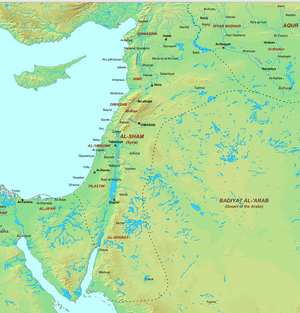Al-Sharat

Al-Sharat (also known as al-Sharah, Bilad al-Sharat or Jibal al-Sharat) is a highland region in modern-day southern Jordan and northwestern Saudi Arabia. It was formerly a sub-district in Bilad al-Sham during the early Islamic era (7th–11th centuries).
Geography
In modern-day Jordan, the Bilad al-Sharat region starts immediately south of Wadi Mujib. The northern range contains mountains with peaks up to 1,200 meters above sea level, while to the south the mountains get as high as 1,500 meters above sea level. The principal city of Bilad al-Sharat is al-Karak.[1] The northern part of the region in Jordan is under the administration of the Karak Governorate, while the more arid part south of Wadi Arabah comes under the Ma'an Governorate.[2]
In the 9th century, al-Sharat's capital was Adhruh,[3] but by the late 10th century, it apparently was replaced by Sughar (Zoar).[4] Other principal towns in the district included Tabuk, Ma'an (Mu'an), Madyan, Aynunah (on the northern Red Sea coast), Wayla (Ayla) and Maab (Rabba).[4]
History
From the beginning of the Muslim conquest of the Levant, al-Sharat formed the southern kurah (district) of Jund Dimashq (Province of Damascus),[5] until the late 9th century, after which it became part of Jund Filastin (Province of Palestine).[6][7] It was the Tulunids who first attached al-Sharat to Filastin for practical purposes, as the district was closer to Filastin than Damascus.[8] In 985, during the late Abbasid period, the Jerusalemite geographer al-Muqaddasi described al-Sharat as its own district, neither belonging to Dimashq nor Filastin, in the larger province of Bilad al-Sham (the Levant).[4]
The district of al-Sharat corresponded with the mountains of Moab.[3] Persian geographer al-Istakhri (d. 957) described the district as "extremely fertile and rich" and dominated by marauding Bedouin tribes.[3] In the late 10th century, the old-established Yamani tribes of Lakhm and Judham were engaged in a struggle over dominance of al-Sharat with newcomers from the tribe of Tayy.[9] Though information about the Fatimid administration over the Levant is vague, Caliph al-Aziz (975–996) may have made al-Sharat (south of Wadi Mujib) its own province which lasted until the Crusader invasion in the early 12th century.[10]
The Crusaders annexed al-Sharat in the 1110s.[11] Initially, it was part of the royal demesne of the Kingdom of Jerusalem, but in 1126, the feudal lordship of Oultrejordain was formed out of the former district of al-Sharat.[11] Its jurisdiction extended from the Zarqa River in the north to the Red Sea in the south.[11] The Crusaders built the fortresses of Montreal (Shawbak) in 1115 and Crac (al-Karak) in 1145.[11][12] Both became major centers of the lordship. By the mid-12th century, the inhabitants of al-Sharat were mainly Bedouin from various Qaysi tribes.[3] At that time, the Muslim geographer Muhammad al-Idrisi (d. 1165) wrote about the fertility of the district and that it produced an abundance of olives, almonds, figs, grapes and pomegranates.[3]
The Bilad al-Sharat was conquered by the Ayyubids under Saladin in 1187.[12] During Ayyubid rule, Syrian geographer Yaqut al-Hamawi (d. 1229) noted that al-Sharat was a mountainous region through which the Hajj caravan road from Damascus to Mecca passed.[3] During Mamluk rule, al-Sharat became Mamlakat al-Karak (Province of al-Karak).[13] By the mid-19th century, Bedouin from the Huwaytat tribe were encroaching into the southern parts of Bilad al-Sharat, and amid the Bedouin-induced anarchy in the region, Christians from Tafilah and al-Karak began fleeing to the north.[14] During that time, Bilad al-Sharat, with the exception of Aqaba, was largely part of the Ottoman district of Mutassarifyya al-Karak.[15]
See also
- Mount Seir, roughly corresponds with al-Sharat
References
- ↑ Salibi 1993, p. 4.
- ↑ Salibi 1993, p. 6.
- 1 2 3 4 5 6 le Strange, p. 35.
- 1 2 3 le Strange, p. 39.
- ↑ le Strange, p. 32.
- ↑ le Strange, p. 28.
- ↑ Salibi 1993, p. 18.
- ↑ Salibi, p. 20.
- ↑ Salibi 1977, p. 74.
- ↑ Johns 1994, p. 10.
- 1 2 3 4 Johns 1994, p. 11.
- 1 2 Salibi 1993, p. 23.
- ↑ Salibi 1993, p. 25.
- ↑ Salibi 1993, p. 27.
- ↑ Salibi 1993, p. 36.
Bibliography
- Johns, Jeremy (1994). "The Long Durée: State and Settlement Strategies in Southern Transjordan across the Islamic Centuries". In Rogan, Eugene L.; Tell, Tariq. Village, Steppe and State: The Social Origins of Modern Jordan. London: British Academic Press.
- Salibi, Kamal S. (1977). Syria Under Islam: Empire on Trial, 634–1097, Volume 1. Delmar: Caravan Books.
- Salibi, Kamal S. (1993). The Modern History of Jordan. I. B. Tauris.
- le Strange, Guy (1890). Palestine Under the Moslems: A Description of Syria and the Holy Land from A.D. 650 to 1500. Committee of the Palestine Exploration Fund.